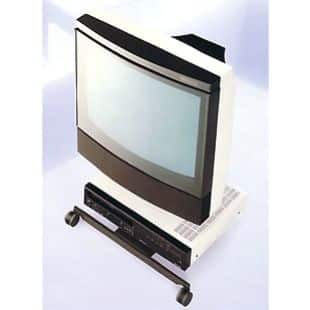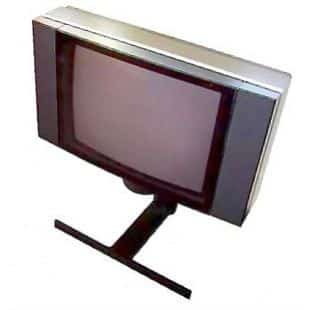BeoVision MX 2000

Beovision MX2000 was a completely different kind of TV. In terms of design, colour and uses it was a departure from tradition. Beovision MX2000 was one of the most stunning and versatile television sets ever created.
Technically the TV was new at the time of its release because of its stereo sound, automatic search for channels and its remote-control. Visually the TV was remarkable because of its contrast screen which reduced the inconvenience of incident light and left the TV dark and discrete when turned off. When turned on the TV was reduced to its function – that of displaying a picture. David Lewis’s design on the MX2000 was detailed and highly aesthetic which made the TV look good from all angles. Because of the pyramidal shape the TV was suitable for placement in corners. The set was a 50cm stereo colour TV that you could literally take with you. Bang & Olufsen’s special VisionClear system ensured that lifelike colours and the best contrast conditions were always obtained… both night and day. And Beovision MX2000 had so many different positioning possibilities that the perfect sound and picture quality could be taken advantage of and enjoyed to the full. Beovision MX2000 was controlled by the remote control Video Terminal. The TV could work with any video tape recorder but the Beocord VHS 82 was a specially designed video recorder that was created to harmonize with the MX2000. Not just when it came to operation but also in design and colour. And the complete, remote-controlled video system could deliver much more than perfect pictures with sound. Beocord VHS 82 was also a stereo audio tape recorder that offered up to eight hours recording on one tape, with hi-fi stereo quality playback. The choice of colour for MX2000 was a matter of personal taste, and style. The choice was yours: rich red for a home abounding in colour and striking contrasts; elegant white; distinguished metallic grey; or black to go with most colour schemes. Beovision MX2000 wasn’t portable TV but it was easy to move around. Grab hold of the built-in handle and Beovision MX2000 went with you. The TV could be put most anywhere. On the floor, shelf, table, window sill and so on. The built-in support on the base even made it possible to tilt the TV backwards. This ensured for a natural, perfect viewing angle when placed low on a floor. The set could of course be put on the practical TV stand which was equipped with solid, easy rolling wheels. And the special mounting platform made it possible to swivel the TV from side to side. The complete remote controlled – Video Terminal – video system could be grouped on a video stand to create one space-saving piece of furniture. It too had solid, easy rolling wheels and allowed the TV to be swivelled from side to side. Beovision MX2000 won the ID Award in 1986. Beovision MX2000 could be both manually operated or operated by remote control. The concealed panel in the top of the TV adjusted all sound and picture functions. But once adjustments to volume, sound, balance, bass, treble, contrast, colour balance and brightness had been made according to the viewer’s wishes and surrounding conditions, the Terminal took over day-to-day usage. Fine-tuning of TV channels, which is generally a once-only task, and stereo width-adjustment were also part of manual control. It was also possible of course, to change over stations and turn on and off the set with the controls on the panel. “Beovision MX2000 gives the impression of lightness and extended freedom of positioning. Now, all of a sudden, the TV could be positioned anywhere – even in the middle of a room” The MX concept began as Beovision M20 in a modest grey cabinet and without a contrast screen. It sort of heralded what a monitor television by Bang & Olufsen might look like. Basically, a monitor is just a screen with a box around it. In the mid-1980s, the emphasis was on the picture and efforts to achieve a monitor look.
The clean screen.
Bang & Olufsen elected to make the television slim by placing the loudspeakers below the screen. This broke with the practice of several decades of placing the loudspeakers at the sides of the picture tube. The latest MX 8000 model incorporates active loudspeakers and the sound has become even better. Previously, and with its Beovision MX 5000, Bang & Olufsen introduced yet another element that, so far, is unique to he company: a motorised base. Now the television turned to face the viewer – not vice versa. Bang & Olufsen had a lot of difficulty explaining Bang & Olufsen’s picture quality, which comprises many individual factors that have been optimised over the years. In1985-86, the decision was made to combine everything that came under the term
“picture quality” into a single concept – VisionClear.
MX2000 was born out of the ideas for the Beovision M20 and was further equipped with VisionClear, including a contrast screen. The MX family became extremely popular and remains so (it is still being produced and sold). Designer David Lewis created a cabinet that fitted around the back of the picture tube, thereby achieving the purely psychological effect of making the picture tube appear smaller than it actually is. Beovision MX 2000 gave the impression of lightness and extended freedom of positioning. Now, all of a sudden, the TV could be positioned anywhere – even in the middle of the room. Bang & Olufsen’s first television in the the US market was a variant, Beovision MX 5000 US. But, because of sales factors and market conditions at the time, it was not a great success. The many features of the Beovision MX2000 were market leaders in their day; however, many of these features are still included, even today, in Bang & Olufsen television sets:
In-line black matrix picture tube.
Part of the VisionClear system which reduces the chance of unintentional mixing of picture colours and ensures perfect pictures throughout the life of the set
Automatic Cut-Off.
Also part of the VisionClear system. This is an electronic circuit that regulates colour balance 50 times a second. A patented Bang & Olufsen circuit that ensures lifelike colours… automatically, and constantly
Contrast screen.
The most visually stunning part of the VisionClear system. At the time of the MX2000 introduction, this was a newly-developed Bang & Olufsen screen that ‘tones down’ the effect of bright light. It ensures that colours are bright and that there is optimum contrast – even in daylight. The rectangular contrast screen provides a wider picture and thereby creates the impression of watching a larger screen Remote-controlled station tuning based on digital technology. Search and tuning of up to 100 channels was carried out automatically after a couple of touches on the Terminal 32 permanent channels and 3 AV channels. Built-in memory which ensured that your favourite channels were right at hand. A touch of one button was all that was needed – and still is right up to the 21st century! Fine tuning: a help feature that was activated manually on the MX2000 when reception conditions were poor or if a TV signal’s frequency was non-standard e.g. in the case of cable TV, home computer etc.. Fine tuning could also be stored in the TV’s memory Display: a small illuminate display in the upper right-hand corner of the screen provided clear responses to almost all orders received from the Terminal Log Line speaker system: a special principle that ensured perfect, lifelike sound reproduction in very compact speakers. The power output was 7 watts sine Stereo-width adjustment: creating the illusion of increased distance between the speakers and providing a wider, fuller sound image Enhanced mono broadcasts: the special stereo-width circuit also improved the sound quality of mono broadcasts Teletext decoder: an optional extra which with a couple of touches on the Terminal gives direct access to the latest news, TV listings, weather forecasts, sports results and so on Built-in clock: during Teletext broadcasts, the correct time can be called on to the screen. This was shown discreetly in the upper right-hand corner On top of this was a wealth of connection options. Beovision MX2000 was awarded the Danish Design Centre’s IP Prize in 1986.

